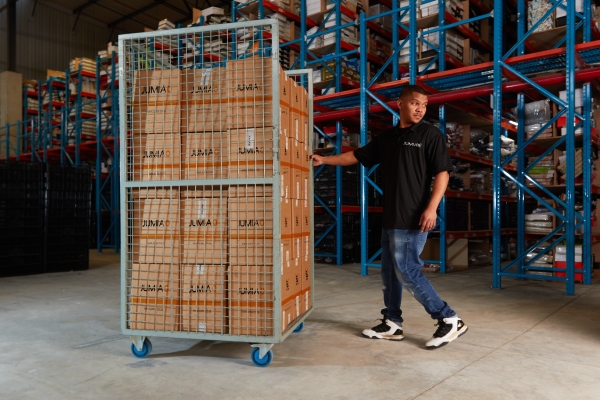Can Kenya get out of the supply chain crisis?

The fourth quarter is drawing to a close, the holiday season has arrived, and Kenyan businesses are closing their books for the year.
Transport and logistics, which support many sectors of the Kenyan economy, appear to be on the rise in many ways. The Kenya Ports Authority (KPA) reported a 4.4 percent increase in container traffic during the first eight months of the year, and Kenya’s brand-new Lamu port opened in May.
However, in addition to positive figures and groundbreaking infrastructure projects that point to an optimistic outlook for the logistics industry, Kenya, like the United States, the United Kingdom, and other countries around the world, is also feeling the effects of a COVID-19-induced supply chain shortage.
Will technology provide a solution to help the industry survive?
A global financial meltdown
On a global scale, the supply chain meltdown began with a container shortage at the end of 2020, with freight rates increasing by more than 264 percent over previous years. Previously, containers moved from China to Europe and North America, but COVID-19 restrictions limited air freight, creating increased demand and preventing containers from returning to East Asia.
Following that, after a pandemic-induced slump, demand for Chinese exports skyrocketed. Global supply chains were already out of balance at this point, with demand for exports exceeding supply of shipping containers.
Shipping container rates from China to the United States and Europe had increased by 300 percent year on year by March 2021.
Trade is being restricted
It all started with a lockdown in Kenya.
The start of the pandemic caused a snarl in Kenya’s transportation industry, which had an immediate impact on the country and the region as a whole.
Industries with markets outside of the East African community took the brunt of the damage. When European countries closed their borders, the East African flower industry, which ships fresh flowers by air to European countries, suffered an estimated $1 billion in losses. Ethiopia, Africa’s second-largest flower exporter, reported an 80% decrease in flower export volume.
Imports to Kenya fell by 23% as a result of limited sea and air routes, but the approval of select land transport that allowed goods to flow by land between borders meant that “other countries in the East African community benefited,” according to Manaseh Otieno, Trade and Policy Manager at the Kenya Association of Manufacturers (KAM). For example, trade between Kenya, a palm oil, petroleum oil, and salt exporter, and Uganda, a milk, tobacco, cane, and energy exporter, increased by 11.3 percent.
However, land transportation between the countries remained slow and prohibitively expensive.
As the number of positive COVID cases in East Africa increased, Rwanda, Uganda, and Kenya agreed to test all truck drivers entering and exiting the three countries. However, due to unequal distribution of COVID-19 resources and insufficient supply chains to get them to East Africa, a limited number of test kits were available. This resulted in a buildup of drivers along the border, lost goods, a decrease in overall truck inflows into Uganda, and a 48 percent increase in shipping costs.
While the flower industry is recovering and trucks are moving more freely, the temporary dismemberment of the supply chain industry may continue to have an impact on East African businesses.
Shortages
The United States is already experiencing inflationary pressures as a result of supply chain issues, which have resulted in a 6.2 percent increase in the US Consumer Price Index (a measure used to estimate price changes in a basket of goods) compared to last year.
Kenya is going through a similar phenomenon.
Bread prices in Kenya increased by $.044 in April for the first time in four years, and they are expected to rise again. The Cereal Millers Association (CMA) attributes the price increase to lower global wheat stocks, marine freight issues, and the rising cost of fuel to its highest level in ten years.
Reliability is essential
Kenya’s potential supply chain crisis and its consequences are avoidable.
Uncertainty, which can be costly in the logistics industry, is a major component of the price increases caused by the current meltdowns.
The market is currently highly uncertain, which can make even the most well-organized businesses difficult.
“The shipping lines are like a small mafia,” said Dr. Simeon Obidairo, co-owner of BoConcept, a contemporary Danish luxury furniture line reopening in Nairobi.
“They tell you the shipping transit time will be six weeks; the shipment leaves, and they end up delivering it 12 weeks later.” As a result, we’ve seen at least double the usual transit times.”
A typical method of organising and tracking shipments to lessen supply chain disruptions is through the use of technology, which, when underutilised, creates major operational kinks that can be cumbersome to correct.
Logi-tech
A new Personal Information Protection Law in China, for example, is preventing some China-based shipping companies from providing real-time shipping information, raising concerns about further shipping disruptions. Because China is home to six of the world’s ten largest container ports, there has been a 90 percent drop in terrestrial shipping data used by businesses to track the arrival and departure of essential goods.
East Africa’s logistics industry is still developing to the point where it is similarly reliant on technology. At the moment, the majority of trade in the region is informal. However, greater dependability is desired: “We need frameworks to support digital trade,” said Manaseh Otieno. “Whatever the client has ordered should be delivered. And if it isn’t, there should be a mechanism in place to deal with these issues.”
Transporters in the region cut back as a result of pandemic-induced demand shocks. As holiday consumption rises and businesses expand capacity, those who fail to become more tech-reliant may find themselves “ill-positioned across the country primarily due to the low adoption of technology by the industry,” according to Tayo Oyegunle, COO of Moove, a logistics platform that provides on-demand solutions to both customers and businesses in East Africa.
Investor interest in the transport and logistics sector remained strong in 2021, with the industry as a whole raising a total of $200 million in Africa during the first eight months of the year. However, much of this has been attributed to the January launch of the African Continental Free Trade Area (AfCFTA), a 34-member-state agreement aimed at removing non-tariff barriers across the African continent.
However, the success of the AfCFTA for Kenya and the region as a whole necessitates greater technological coordination. Without it, it could be years before supply chain issues are resolved and a more open trading environment is realized.







